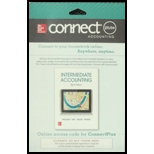
Concept explainers
1.
Inventory errors: It refers to the errors that result in overstatement or understatement of ending inventory caused due to wrong physical inventory count or wrong price fixation of the inventory quantities. It also includes overstatement or understatement of purchases caused to wrong inventory cut-off. These errors are rectified by reversing the original erroneous entry and recording the correct entry.
To Determine: the correct amounts for 2016 purchases, accounts payable, sales revenue, and
2.
To calculate: the ending inventory and cost of goods sold for 2016.
3.
To describe: the steps that Company C would undertake to correct the error in the 2015 ending inventory and the effect of the error on the 2015 before-tax income.
Want to see the full answer?
Check out a sample textbook solution
Chapter 9 Solutions
INTERMEDIATE ACCT.-CONNECT PLUS ACCESS

 AccountingAccountingISBN:9781337272094Author:WARREN, Carl S., Reeve, James M., Duchac, Jonathan E.Publisher:Cengage Learning,
AccountingAccountingISBN:9781337272094Author:WARREN, Carl S., Reeve, James M., Duchac, Jonathan E.Publisher:Cengage Learning, Accounting Information SystemsAccountingISBN:9781337619202Author:Hall, James A.Publisher:Cengage Learning,
Accounting Information SystemsAccountingISBN:9781337619202Author:Hall, James A.Publisher:Cengage Learning, Horngren's Cost Accounting: A Managerial Emphasis...AccountingISBN:9780134475585Author:Srikant M. Datar, Madhav V. RajanPublisher:PEARSON
Horngren's Cost Accounting: A Managerial Emphasis...AccountingISBN:9780134475585Author:Srikant M. Datar, Madhav V. RajanPublisher:PEARSON Intermediate AccountingAccountingISBN:9781259722660Author:J. David Spiceland, Mark W. Nelson, Wayne M ThomasPublisher:McGraw-Hill Education
Intermediate AccountingAccountingISBN:9781259722660Author:J. David Spiceland, Mark W. Nelson, Wayne M ThomasPublisher:McGraw-Hill Education Financial and Managerial AccountingAccountingISBN:9781259726705Author:John J Wild, Ken W. Shaw, Barbara Chiappetta Fundamental Accounting PrinciplesPublisher:McGraw-Hill Education
Financial and Managerial AccountingAccountingISBN:9781259726705Author:John J Wild, Ken W. Shaw, Barbara Chiappetta Fundamental Accounting PrinciplesPublisher:McGraw-Hill Education





